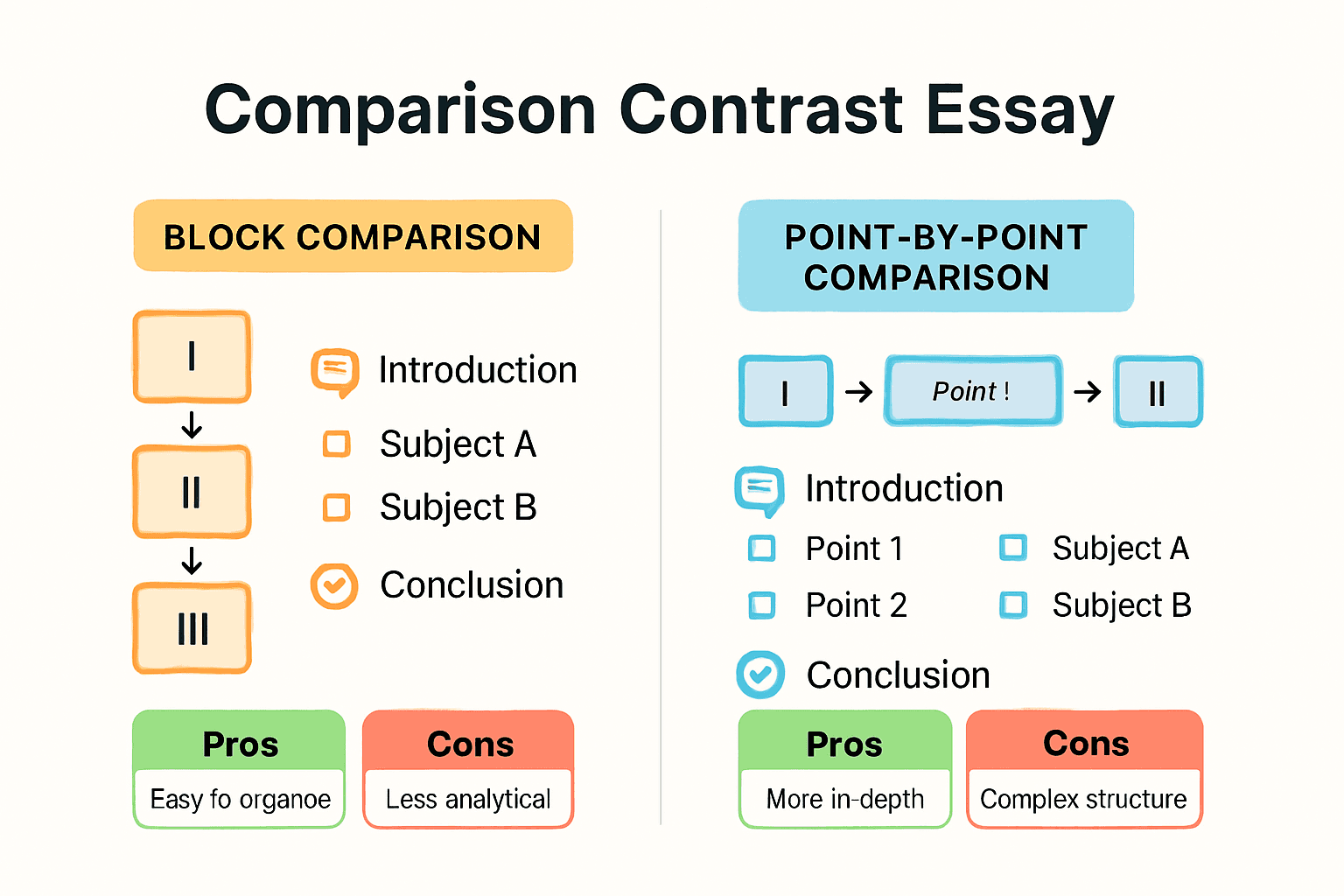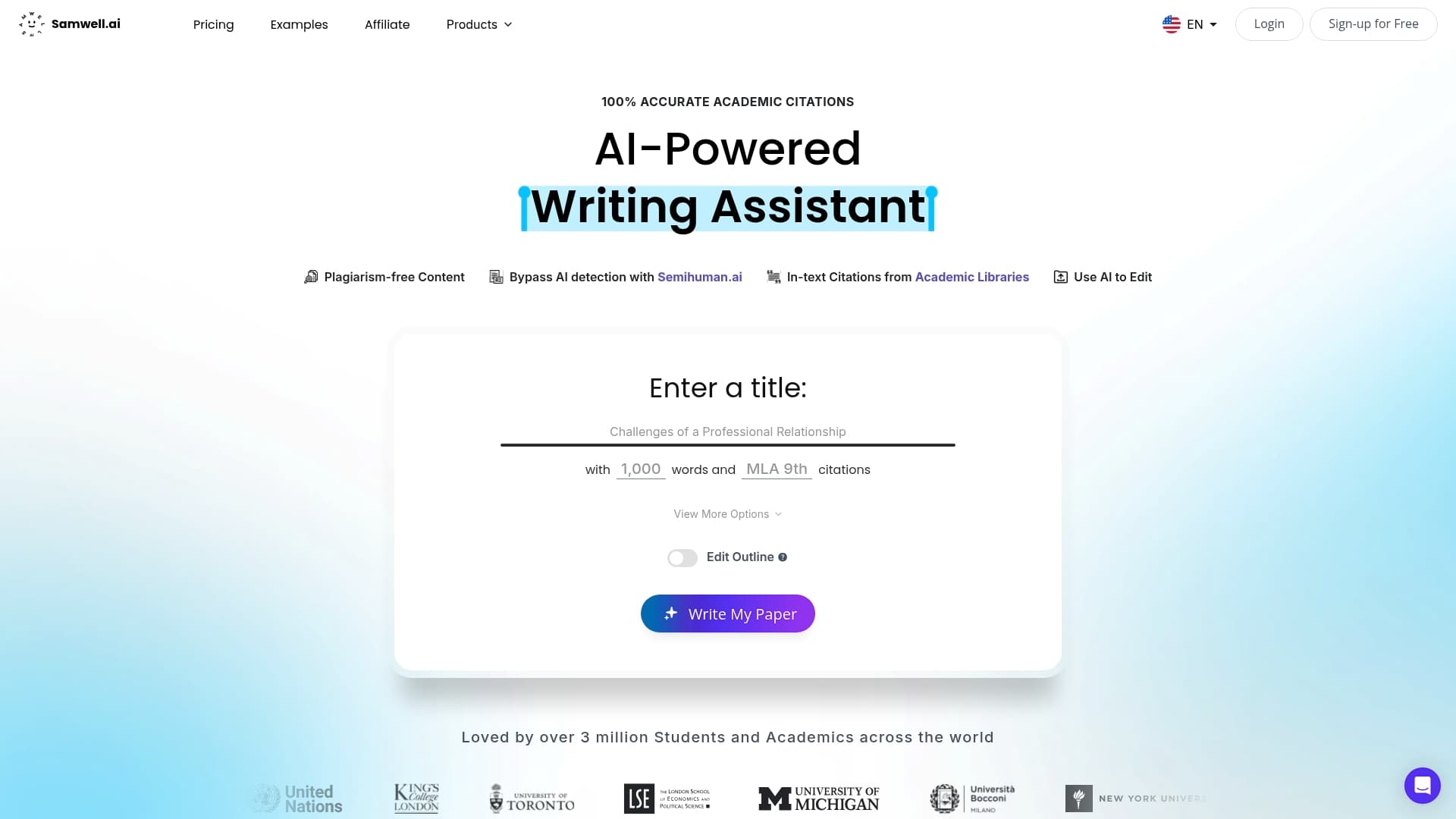Blog
Learning Materials
How to Write a Comparison Contrast Essay Outline Easily
Updated: August 13, 2025

Writing a comparison contrast essay outline sounds straightforward. Pick two subjects and organize their similarities and differences. But most students get tripped up at the very first step. Nearly 60 percent of college essays lack a clear organizational method which makes them hard to follow and weak in argument. The real breakthrough happens when you master just two simple outline structures that instantly turn your draft from a list of random ideas into a focused, persuasive argument.
Table of Contents
- What Is A Comparison Contrast Essay Outline Dockerfile README.md email-templates i18n-config.ts i18nConfig.ts next-sitemap-samwell.config.js next-sitemap-semihuman.config.js next.config.js node_modules package-lock.json package.json public scripts src svgr.d.ts translations tsconfig.json Understanding The Core Purpose Dockerfile README.md email-templates i18n-config.ts i18nConfig.ts next-sitemap-samwell.config.js next-sitemap-semihuman.config.js next.config.js node_modules package-lock.json package.json public scripts src svgr.d.ts translations tsconfig.json Structural Approaches To Comparison Contrast Outlines
- Key Steps To Build Your Essay Outline Dockerfile README.md email-templates i18n-config.ts i18nConfig.ts next-sitemap-samwell.config.js next-sitemap-semihuman.config.js next.config.js node_modules package-lock.json package.json public scripts src svgr.d.ts translations tsconfig.json Select Your Subjects And Establish Comparison Points Dockerfile README.md email-templates i18n-config.ts i18nConfig.ts next-sitemap-samwell.config.js next-sitemap-semihuman.config.js next.config.js node_modules package-lock.json package.json public scripts src svgr.d.ts translations tsconfig.json Develop A Strategic Outline Structure Dockerfile README.md email-templates i18n-config.ts i18nConfig.ts next-sitemap-samwell.config.js next-sitemap-semihuman.config.js next.config.js node_modules package-lock.json package.json public scripts src svgr.d.ts translations tsconfig.json Craft A Compelling Thesis And Supporting Evidence
- Effective Outline Examples And Best Practices Dockerfile README.md email-templates i18n-config.ts i18nConfig.ts next-sitemap-samwell.config.js next-sitemap-semihuman.config.js next.config.js node_modules package-lock.json package.json public scripts src svgr.d.ts translations tsconfig.json Structural Templates For Comparison Contrast Outlines Dockerfile README.md email-templates i18n-config.ts i18nConfig.ts next-sitemap-samwell.config.js next-sitemap-semihuman.config.js next.config.js node_modules package-lock.json package.json public scripts src svgr.d.ts translations tsconfig.json Best Practices For Crafting Compelling Outlines Dockerfile README.md email-templates i18n-config.ts i18nConfig.ts next-sitemap-samwell.config.js next-sitemap-semihuman.config.js next.config.js node_modules package-lock.json package.json public scripts src svgr.d.ts translations tsconfig.json Advanced Outline Refinement Strategies
- Expert Tips For Stronger Comparison Essays Dockerfile README.md email-templates i18n-config.ts i18nConfig.ts next-sitemap-samwell.config.js next-sitemap-semihuman.config.js next.config.js node_modules package-lock.json package.json public scripts src svgr.d.ts translations tsconfig.json Developing A Sophisticated Analytical Framework Dockerfile README.md email-templates i18n-config.ts i18nConfig.ts next-sitemap-samwell.config.js next-sitemap-semihuman.config.js next.config.js node_modules package-lock.json package.json public scripts src svgr.d.ts translations tsconfig.json Crafting Precise And Compelling Arguments Dockerfile README.md email-templates i18n-config.ts i18nConfig.ts next-sitemap-samwell.config.js next-sitemap-semihuman.config.js next.config.js node_modules package-lock.json package.json public scripts src svgr.d.ts translations tsconfig.json Advanced Comparative Writing Techniques
Quick Summary
| Takeaway | Explanation |
|---|---|
| Select relevant subjects carefully | Choose subjects with meaningful similarities and differences to facilitate deeper analysis. |
| Utilize an effective outline structure | Use either block or point-by-point methods to organize your comparative analysis coherently. |
| Create a clear thesis statement | Your thesis should articulate the significant insights gained from the comparison, guiding your arguments. |
| Integrate substantial supporting evidence | Gather research and data that directly supports your comparative points, enhancing overall credibility. |
| Embrace advanced analytical techniques | Explore nuanced connections and challenge conventional views to offer deeper insights through your essay. |
What Is a Comparison Contrast Essay Outline
A comparison contrast essay outline is a structured writing blueprint that helps students systematically organize and present similarities and differences between two or more subjects. According to the University of North Carolina at Chapel Hill Writing Center, this outline serves as a critical roadmap for writers to effectively analyze and communicate complex relationships between subjects.
Understanding the Core Purpose
At its fundamental level, a comparison contrast essay outline provides a clear framework for exploring the nuanced connections and distinctions between topics. Writing Commons highlights that the outline helps writers develop a focused thesis statement and organize supporting evidence in a logical manner. The primary goal is not just to list similarities and differences but to generate meaningful insights that provide deeper understanding.
The outline typically includes three essential components: an introduction with a compelling thesis, a structured body that presents comparative analysis, and a conclusion that synthesizes the key findings. By creating this blueprint before writing, students can ensure their essay maintains a coherent argument and avoids becoming a mere laundry list of similarities and differences.
Structural Approaches to Comparison Contrast Outlines
Writers can choose between two primary organizational methods when developing their comparison contrast essay outline. The first is the block method, where you discuss all characteristics of one subject thoroughly before moving to the next subject. This approach works well when subjects have complex characteristics that require in-depth exploration.
The alternative is the point-by-point method, which alternates between subjects for each comparative point. This technique creates a more dynamic reading experience and allows for direct side-by-side analysis. Students can explore our comprehensive essay outline guide to understand these structural nuances better.
Each method has its strengths, and the choice depends on the specific subjects being compared, the complexity of the analysis, and the writer's strategic objectives.
To help you compare the two main organizational methods for a comparison contrast essay, here's a table outlining their key features, advantages, and best-use scenarios:
| Method | Description | Advantages | Best Used When |
|---|---|---|---|
| Block Method | Discuss all points about Subject A, then all points about Subject B | Comprehensive coverage of each subject | Each subject is complex or needs depth |
| Point-by-Point | Alternate between subjects for each comparison point | Direct, dynamic analysis; easy to follow | You want side-by-side analysis |
Regardless of the chosen approach, a well-crafted comparison contrast essay outline ensures that the final paper remains focused, logical, and intellectually engaging.
Successful comparison contrast essays go beyond surface-level observations. They require critical thinking, careful research, and a structured approach to revealing meaningful connections and distinctions between subjects. The outline serves as the foundation for this intellectual exploration, guiding writers through a systematic process of analysis and interpretation.
Key Steps to Build Your Essay Outline
According to the University of North Carolina at Chapel Hill Writing Center, creating a robust comparison contrast essay outline requires strategic planning and systematic organization. The process involves several critical steps that transform your initial ideas into a coherent and compelling academic document.
Select Your Subjects and Establish Comparison Points
The foundation of a successful comparison contrast essay begins with carefully selecting subjects that offer meaningful points of comparison. Choose topics that share some inherent characteristics while maintaining significant differences. This approach allows for a nuanced exploration of relationships and distinctions.
When identifying comparison points, consider multiple dimensions such as:
- Structural similarities: Underlying frameworks or organizational principles
- Functional characteristics: How subjects operate or perform
- Historical or contextual backgrounds: Origins and developmental trajectories
- Theoretical implications: Conceptual frameworks and interpretative perspectives
Each selected point should contribute to a deeper understanding of the subjects being analyzed. Avoid superficial observations and focus on substantive insights that reveal complex interconnections.
Develop a Strategic Outline Structure
Once you have identified your subjects and comparison points, select an organizational approach that best serves your analytical goals. Students can explore our comprehensive essay outline guide to understand the intricacies of different structural methods.
The two primary approaches include:
- Block Method: Dedicates entire sections to individual subjects, providing comprehensive coverage of each topic before transitioning
- Point-by-Point Method: Alternates between subjects for each comparative dimension, creating a more dynamic analytical flow
Your chosen method should align with the complexity of your subjects and the specific requirements of your academic assignment. Consider factors such as the depth of analysis required, the number of comparison points, and the overall length of the essay.
Craft a Compelling Thesis and Supporting Evidence
A strong comparison contrast essay outline hinges on a clear, arguable thesis statement that articulates the purpose of your comparative analysis. Your thesis should not merely announce the subjects being compared but also indicate the significant insights emerging from their examination.
Supporting evidence plays a crucial role in substantiating your comparative arguments. Gather relevant research, statistical data, expert quotations, and contextual information that illuminates the similarities and differences between your chosen subjects. Ensure that each piece of evidence directly supports your comparative points and contributes to the overall argumentative trajectory.
Remember that a well-constructed outline serves as a roadmap, guiding your writing process and helping you maintain focus. By investing time in careful planning and strategic organization, you create a solid foundation for a sophisticated and intellectually engaging comparison contrast essay.
Effective Outline Examples and Best Practices
According to the University of North Carolina at Chapel Hill Writing Center, developing an effective comparison contrast essay outline requires strategic planning and careful organization. This section explores practical examples and best practices that transform your initial ideas into a sophisticated academic document.
Structural Templates for Comparison Contrast Outlines
Effective comparison contrast essay outlines typically follow two primary structural frameworks. The first is the block method, which dedicates comprehensive sections to individual subjects. The second is the point-by-point method, which alternates comparative analysis across different dimensions.

Block Method Outline Example:
I. Introduction A. Background context B. Thesis statement
II. Subject A A. Characteristic 1 B. Characteristic 2 C. Characteristic 3
III. Subject B A. Characteristic 1 B. Characteristic 2 C. Characteristic 3
IV. Conclusion A. Summary of key similarities B. Summary of key differences C. Broader implications
Point-by-Point Method Outline Example:
I. Introduction A. Background context B. Thesis statement
II. Comparative Characteristic 1 A. Analysis for Subject A B. Analysis for Subject B C. Comparative insights
III. Comparative Characteristic 2 A. Analysis for Subject A B. Analysis for Subject B C. Comparative insights
IV. Conclusion A. Summary of key similarities B. Summary of key differences C. Broader implications
Best Practices for Crafting Compelling Outlines
Developing a robust comparison contrast essay outline requires adherence to several critical best practices. Students can explore our comprehensive essay outline strategies to refine their approach.
Below is a summary table of best practices for creating a compelling comparison contrast essay outline, based on the recommendations listed in the article:
| Best Practice | Description |
|---|---|
| Maintain Balanced Coverage | Provide equal depth for both subjects |
| Use Clear Organizational Logic | Choose a method that highlights key comparative insights |
| Develop Precise Thesis Statements | Go beyond observations; state the essay's comparative purpose |
| Integrate Substantive Evidence | Support arguments with research and analysis |
Key Recommendations:
- Maintain Balanced Coverage: Ensure equal depth and detail when analyzing both subjects
- Use Clear Organizational Logic: Select a method that highlights the most meaningful comparative insights
- Develop Precise Thesis Statements: Articulate the specific comparative purpose beyond surface-level observations
- Integrate Substantive Evidence: Support comparative arguments with credible research and analytical insights
Advanced Outline Refinement Strategies
Beyond basic structural considerations, advanced writers focus on nuanced approach to comparative analysis. This involves:
- Identifying subtle interconnections between subjects
- Exploring complex contextual relationships
- Challenging conventional understanding through innovative comparative perspectives
- Developing multilayered analytical frameworks that transcend simple similarities and differences
Successful comparison contrast essays move beyond descriptive cataloging. They generate new understanding by revealing unexpected connections, challenging existing perceptions, and presenting sophisticated intellectual interpretations of complex subjects.
Remember that an outline is more than a mechanical template. It represents an intellectual journey of discovery, guiding readers through a carefully constructed comparative narrative that illuminates deeper truths about the subjects under examination.
Expert Tips for Stronger Comparison Essays
According to the University of North Carolina at Chapel Hill Writing Center, crafting a compelling comparison essay requires more than simply listing similarities and differences. Expert writers approach these essays as sophisticated analytical explorations that reveal deeper insights about the subjects under examination.
Developing a Sophisticated Analytical Framework
Successful comparison essays transcend surface-level observations by establishing a nuanced analytical approach. This involves moving beyond mere description to create meaningful connections that illuminate complex relationships between subjects. Students can explore advanced writing strategies in our comprehensive guide to enhance their analytical skills.
Key Analytical Strategies:
- Contextual Depth: Investigate the broader historical, cultural, or theoretical contexts that shape your subjects
- Critical Perspective: Challenge conventional understanding by identifying unexpected connections
- Multidimensional Analysis: Examine subjects through multiple interpretative lenses
- Substantive Evidence: Ground comparisons in credible research and empirical data
Crafting Precise and Compelling Arguments
The strength of a comparison essay lies in its ability to generate new understanding through carefully constructed arguments. Expert writers focus on several critical elements:
Argument Development Techniques:
- Clear Thesis Formulation: Develop a thesis that goes beyond simple observation
- Balanced Representation: Ensure equitable and fair treatment of both subjects
- Logical Progression: Create a coherent narrative that guides readers through comparative insights
- Sophisticated Transitions: Use strategic language that connects comparative points seamlessly
Advanced Comparative Writing Techniques
Mastering comparison essays requires developing sophisticated writing techniques that elevate analytical discourse. This involves:
- Identifying subtle interconnections that are not immediately apparent
- Challenging existing theoretical frameworks
- Presenting complex arguments with clarity and precision
- Demonstrating intellectual agility in analyzing diverse subjects
The most exceptional comparison essays do more than compare and contrast. They generate new knowledge by revealing unexpected relationships, challenging preconceived notions, and presenting innovative perspectives that transform our understanding of the subjects.
Writers should approach comparison essays as intellectual investigations. Each comparative point should serve a larger argumentative purpose, contributing to a comprehensive understanding that transcends individual subject characteristics.
Remember that a truly powerful comparison essay is not about declaring one subject superior to another. Instead, it's an opportunity to explore the intricate ways different subjects intersect, diverge, and ultimately illuminate broader intellectual landscapes.
By embracing these expert strategies, you can transform a basic comparison essay into a sophisticated analytical work that engages readers, challenges assumptions, and contributes meaningful insights to academic discourse.

Frequently Asked Questions
What is a comparison contrast essay outline?
A comparison contrast essay outline is a structured framework used to organize and present the similarities and differences between two or more subjects. It helps writers effectively analyze and communicate complex relationships in a coherent manner.
What are the main structural approaches to a comparison contrast essay outline?
The two primary structural approaches are the block method, where all points about one subject are discussed before transitioning to the next, and the point-by-point method, which alternates between subjects for each comparative point, allowing for side-by-side analysis.
How do I create a strong thesis statement for a comparison contrast essay?
A strong thesis statement should clearly articulate the purpose of your comparison and reflect significant insights gained from the analysis. It should go beyond merely stating the subjects being compared to highlight the insights that emerge from their evaluation.
What are some best practices for crafting a compelling outline?
Best practices include maintaining balanced coverage of both subjects, using clear organizational logic, developing precise thesis statements, and integrating substantial evidence to support your comparative arguments.
Tired of Messy Outlines and Overwhelming Essay Drafts?
Struggling to transform your ideas into a clear, persuasive comparison contrast essay outline? You are not alone. Many students, as highlighted in this article, find it challenging to move from brainstorming to building a logical outline with a precise thesis, cohesive structure, and strong supporting evidence. Using the point-by-point or block method can seem simple in theory, but actually applying these structures to your research and ideas often leads to stress, wasted time, and drafts that lack focus. It feels especially frustrating knowing your insights deserve a stronger framework and a more credible presentation.

Why settle for overwhelming drafts or outlines that do not capture your best analysis? Samwell.ai is here to bridge the gap between your ideas and a polished, academically sound comparison contrast essay. With guided outlines, real-time AI checks, and a customizable Power Editor, you can quickly organize your essay, ensure academic integrity, and concentrate on what matters most—your critical insights. Join over one million students who have streamlined their writing process instead of struggling alone. Start now and experience the difference on Samwell.ai.
Generate essays with Samwell.ai
Whether you’re a publisher, professor, journalist, or student, let us tailor a plan just for you.Most Read Articles

Your Guide to Help Writing a Essay Successfully
Expert tips for help writing a essay - from crafting a thesis to structuring your essay effectively.

How to Write Critical Thinking Essay: Expert Tips
Expert tips for writing a critical thinking essay. Learn how to structure, choose topics, and use evidence effectively.'

How to Write a Good Hook: A Step-by-Step Guide
Master the art of crafting a good hook with our guide. Create compelling openers for a memorable first impression.
